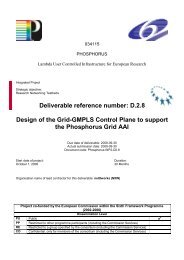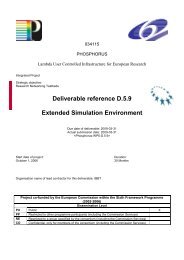Grid Job Routing Algorithms - Phosphorus
Grid Job Routing Algorithms - Phosphorus
Grid Job Routing Algorithms - Phosphorus
Create successful ePaper yourself
Turn your PDF publications into a flip-book with our unique Google optimized e-Paper software.
<strong>Grid</strong> <strong>Job</strong> <strong>Routing</strong> <strong>Algorithms</strong>It can be noticed that by selecting a proper wavelength assignment scheme, the overall blocking percentage ofthe network can be considerably reduced. The PS-IAWA outperforms first fit and random wavelengthassignment schemes and exhibits similar performance behaviour with the more computational intensive IAWAscheme which calculates the Q-factor of all potential wavelengths that can be used to establish a lightpath eachtime a path is considered, whereas the PS-IAWA does not require any further calculations once the order of thewavelengths has been discovered at the beginning of the simulation. For low power levels in the DCF segment(-4dB to 2dB) the observed improvement is around 5% between the IAWA schemes and the random WAscheme, and more than 20% compared with First Fit scheme. The significant advantage of IAWA schemes isbecomes more apparent when the power levels of the DCF increase. In such cases, a considerable gain isachieved by introducing the IAWA schemes which range from 20% to 40% compared with the random WA caseand is even more for the first fit scheme. Similar conclusions can be drawn as the power in the SMF fiberincreases, where the benefit is more than 10% for the majority of the input powers between IAWA schemes andrandom WA. Therefore by applying IAWA schemes in the network a wider range of input powers can betolerated in both SMF and DCF segments. Also introducing our ICBR algorithm for the path computationprocedure proves to be beneficial against the conventional shortest path as demonstrated by comparing figuresFigure 6.12a and Figure 6.12c with Figure 6.12b and Figure 6.12d respectively. A noticeable improvement,around 10% is indicated at least for cases where the blocking percentage is in an acceptable level as it appearswhen IAWA schemes are implemented. Consequently, the combination of a proper WA assignment schemewith an ICBR algorithm provides significant performance improvement in the network.Simulation results based on the PHOSPHORUS Global scenarioHere the evaluation of the Impairment Constraint Based <strong>Routing</strong> algorithm is performed by applying thealgorithm to the PHOSPHORUS global topology illustrated in Figure 5.1.The PHOSPHORUS Global network topology is generated by expanding the PHOSPHORUS Europeanscenario to include two additional North American nodes and therefore it consists of 9 nodes interconnectedwith 16 bidirectional links. The link length distribution for this scenario is depicted in Figure 6.13 (right) where itis noticed that the link lengths cover a range from 40 to 9000km, with the average link length being 2692.54km.In the majority of the simulations it is assumed that there are connection requests between every possible pairof nodes and therefore 36 end-to-end connections are requested to be established. The number of nodes thatparticipate in these 36 connections is presented in Figure 6.13 (left) when ICBR is used for the discovery of theroutes.Project:PHOSPHORUSDeliverable Number: D.5.3Date of Issue: 31/06/07EC Contract No.: 034115Document Code: <strong>Phosphorus</strong>-WP5-D5.369






